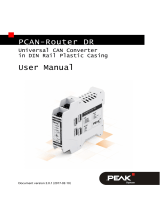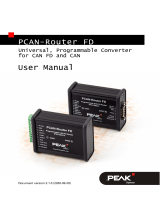Page is loading ...

Visualization, Recording, and
Playback of CAN Data
User Manual
PCAN-MiniDisplay
Document version 2.4.0 (2019-11-19)

PCAN-MiniDisplay – User Manual
2
Relevant products
Product name Model Firmware
Part number
PCAN-MiniDisplay Display with
mounting frame
IPEH-002262
(from serial number 150)
PCAN-MiniDisplay
Case
Display in casing with
push buttons
V1.4.0 or
higher
IPEH-002262-KSM01
(from serial number 12215)
The front page shows the PCAN-MiniDisplay with mounting frame.
PCAN® is a registered trademark of PEAK-System Technik GmbH. microSD™ is a
trade
mark or registered trademark of SD-3C, LLC in the United States of America,
other countries, or both.
All other product names in this document may be the trademarks or registered
trademarks of their respective companies. They are not explicitly marked by ™ or ®.
Copyright © 2019 PEAK-System Technik GmbH
Duplication (copying, printing, or other forms) and the electronic distribution of this
document is only allowed with explicit permission of PEAK-System Technik GmbH.
PEAK-System Technik GmbH reserves the right to change technical data without
prior announcement. The general business conditions and the regulations of the
license agreement apply. All rights are reserved.
PEAK-System Technik GmbH
Otto-Roehm-Strasse 69
64293 Darmstadt
Germany
Phone: +49 (0)6151 8173-20
Fax: +49 (0)6151 8173-29
www.peak-system.com
info@peak-system.com
Doc
ument version 2.4.0 (2019-11-19)

PCAN-MiniDisplay – User Manual
3
Contents
1 Introduction 5
1.1 Properties at a Glance 6
1.2 Scope of Supply 7
2 Connectors 8
2.1 J1 External Buttons 9
2.2 J2 System 9
2.3 J3 and J7 USB 10
2.4 J4 JTAG 12
2.5 J5 microSD 12
2.6 J6 Serial 13
3 Scene Definition 14
3.1 General Description of an *.ins File 14
3.2 Example of an *.ins File 16
3.3 Using Several Scenes 18
4 Steps to Operation 19
4.1 Prerequisites 19
4.2 Preparing the Memory Card 19
4.3 Powering On the Device 21
4.4 Menus 22
4.5 Setting the Startup Options 23
5 CAN Tracing 25
5.1 Recording CAN Traffic 25
5.2 Playing Back Recorded CAN Traffic 29
5.3 Using the Recorded CAN Traffic on the PC 30
5.4 Filtering the CAN Traffic at Recording 32

PCAN-MiniDisplay – User Manual
4
6 Settings and Maintenance 33
6.1 Device Settings 33
6.2 Internal Statistics 36
6.3 Memory Card 36
7 Using Own Pictures 38
7.1 Alternative Startscreen 39
8 Technical Specifications 40
Appendix A CE Certificate 42
Appendix B Dimension Drawing 43
Appendix C Structure on the Memory Card 45
Appendix D Definition Files Reference 47
D.1 Scene Definition (*.ins) 47
D.2 Scenes Project File (*.inp) 78
D.3 CAN ID Filters (*.flt) 79
Appendix E Model with Casing 82
E.1 Scope of Supply 82
E.2 Push Buttons 83
E.3 Connectors 83
E.4 microSD Card Slot 84
E.5 Technical Specifications Casing Model 86

PCAN-MiniDisplay – User Manual
5
1 Introduction
The PCAN-MiniDisplay is used as a human-machine interface for
the visualization of CAN data. For the connection to the CAN bus, it
has two High-speed CAN connectors. The graphic representation of
incoming CAN data is configured before using the unit and then is
performed on a TFT display.
The PCAN-MiniDisplay can alternatively be used for data logging.
The data traffic is recorded to a memory card and can be replayed
or analyzed on a PC later on.
In addition to the built-in PCAN-MiniDisplay there is a version in
plastic casing with push buttons available. This can be used to
create and evaluate application-specific configurations.
Furthermore, the user can directly switch between different
configurations during operation.
The specific features of the PCAN-MiniDisplay with casing (IPEH-
002262-KSM01) are described in Appendix E on page 82.
Note: This user manual refers to devices that were delivered
from July 2017 onwards (see
Relevant products
on page 2).
Owners of older PCAN-MiniDisplays please note the informa-
tion on the firmware update in the section
Internal Statistics
on
page 36.

PCAN-MiniDisplay – User Manual
6
1.1 Properties at a Glance
CAN connections via 2 High-speed CAN channels (ISO 11898-2)
Bit rates from 40 kbit/s up to 1 Mbit/s
Complies with CAN specifications 2.0 A/B
NXP TJA1041 CAN transceiver with wake-up
2 analog inputs
Resolution 10 bit
Measuring range 0 - 16.5 V
1 digital input and 1 digital output
TFT display with 320 x 240 pixel resolution
Freely configurable visualization of CAN data via text files
Display of texts, CAN data as well as the values of the
analog and digital inputs via text labels
Formattable output of CAN data as numbers, float
numbers, or strings with consideration of enums and
multiplexers
Display of bitmap images with transparency
Signal-dependent display of image lists
Presentation of multiple signal curves in plotters
Configurable access to key and buzzer functions as well
as display brightness via CAN
Transmitting CAN frame sequences at the start,
operation, and end of a configuration
Slot for microSD memory card (max. 32 GByte)
High-speed USB 2.0 port for memory card access using a PC
Running configurations from the memory card

PCAN-MiniDisplay – User Manual
7
Optional auto-start of a single configuration or recording on
power-up
Recording of incoming CAN messages to the internal memory
card, optionally including occurring errors
CAN ID filtering for recordings, separately configurable for each
CAN channel
Conversion of recordings to various output formats using
Windows software
Playback of a recording with optional loop function
Use of optionally equipped push buttons for menu navigation
and to switch between multiple display configurations
Dimensions: 80 x 55 mm
Voltage supply from 7 to 30 V
Operating temperature range from -20 to 70 °C (-4 to 158 °F)
1.2 Scope of Supply
PCAN-MiniDisplay with mounting frame
Cables for power supply, CAN, and digital inputs
512 MB memory card installed
Conversion software PEAK-Converter for Windows 10, 8.1, 7
(32/64-bit)
Configuration examples
Manual in PDF format

PCAN-MiniDisplay – User Manual
8
2 Connectors
The connectors on the circuit board are:
J1 External buttons (2.1 en page 9)
J2 System (2.2 on page 9)
J3 and J7 USB (2.3 on page 10)
J4 JTAG (2.4 on page 12)
J5 microSD (2.5 on page 12)
J6 Serial (2.6 on page 13)
For basic use, at least the power supply (J2), a CAN connection (J2),
and a microSD memory card (J5) are needed.
Figure 1: Bottom side of the PCAN-MiniDisplay board;
connectors J1, J2, J3, J4, J6, J7;
pin 1 marked red

PCAN-MiniDisplay – User Manual
9
2.1 J1 External Buttons
3 push buttons can be connected and used to navigate through the
menus of the PCAN-MiniDisplay user interface. This is for mainte-
nance and debugging purposes. For example, a user of the PCAN-
MiniDisplay can be enabled to do communication configuration
changes or CAN tracing.
Figure 2: Pin assignment J1 external
Buttons
Pin Function
1 Din1: Down
2 Din2: Up
3 Din3: Enter
4 GND
The 3 push buttons connect each function pin (1 to 3) to GND.
2.2 J2 System
Power supply
2 High-speed CAN channels (CAN1 and CAN2)
1 digital output, 1 digital input, 2 analog inputs
Figure 3: Pin assignment J2 System
Pin Function
1 Vb (7 - 30 V DC)
2 GND
3 Dout1
4 Din4
5 Ain1
6 Ain2
7 CAN2_L
8 CAN2_H
9 CAN1_L
10 CAN1_H

PCAN-MiniDisplay – User Manual
10
The digital and analog inputs can be used, for example, for the
instrument display. Further technical information for the inputs and
the digital output of the J2 System connector can be found in
Technical Specifications
on page 40.
2.3 J3 and J7 USB
The connections J3 and J7 (Mini-USB port) can be used for access
to the memory card in the PCAN-MiniDisplay from a PC via a USB
connection. The memory card can also be accessed with the PCAN-
MiniDisplay switched off. When the device is switched on, the USB
connection is interrupted shortly.
Figure 4: Pin assignment J3 USB
Pin Function
1 5 V USB
2 D-
3 D+
4 GND
5 GND
Figure 5: Pin assignment J7 USB
(Mini-USB)
Pin Function
1 5 V USB
2 D-
3 D+
4 not connected
5 GND

PCAN-MiniDisplay – User Manual
11
2.3.1 Unplugging the USB Connection
Before unplugging the USB cable from the PC or the PCAN-
MiniDisplay, the device should be logged out of the operating
system. This procedure ensures that the operating system has
correctly finished a write process to the memory card of the PCAN-
MiniDisplay.
Figure 6: Safely remove hardware windows icon
in the taskbar notification area
2.3.2 Restriction for PCAN-MiniDisplay Functions
During a USB connection to a PC some functions of the PCAN-
MiniDisplay are limited, because the device cannot access the
memory card at the same time as the connected PC:
Scene definitions (instruments) cannot be loaded.
The recording and playback of CAN traffic (trace) do not work.
The commands in the Memory Card menu do not work.

PCAN-MiniDisplay – User Manual
12
2.4 J4 JTAG
Access the microcontroller for debugging purposes.
Figure 7: Pin assignment J4 JTAG
Pin Function
1 GND
2 GND
3 Reset#
4 3.3 V
5 TCK
6 TMS
7 TDO
8 TDI
9 RTCK
10 TRST
2.5 J5 microSD
Slot for a microSD memory card (max. 32 GByte).
Figure 8: Location of the microSD card slot
on the circuit board of the PCAN-MiniDisplay (bottom view)

PCAN-MiniDisplay – User Manual
13
2.6 J6 Serial
Provides serial signals for customer-specific extensions.
Figure 9: Pin assignment J6 Serial
Pin Function
1 GND
2 5 V
3 TxD RS-232
4 RxD RS-232
5 DBG
6 Buzzer
Note: The serial pins RxD and TxD are not supported by the
standard firmware.

PCAN-MiniDisplay – User Manual
14
3 Scene Definition
The PCAN-MiniDisplay uses a so-called scene to display CAN data
in graphical form.
Note: Running a display configuration as well as recording and
playback of CAN messages is not possible at the same time.
The PCAN-MiniDisplay can only be used with one of the three
functions.
3.1 General Description of an *.ins File
A scene is a collection of instruments, labels, fonts, etc. defined in a
text file with the *.ins extension. Scenes furthermore include
bitmap graphic files (*.bmp) and font files (*.fon).
The content of a scene definition file is divided in different sections
each containing definition entries:
[global]: general specifications for the scene
[fontX]: fonts that are used by labels
[messageX]: messages for the use by variables, multiplexer
variables, and for assigning the CAN channel 1 or 2.
[enumX]: enumeration value lists for a user-defined output of
specific values of variables.
[variableX]: Variables for representing the data of CAN
messages or the analog or digital inputs. Output with labels, the
plotter, or instruments.
[txlist_X]: CAN frame sequences that can be transmitted at the
start, operation, and end of a configuration

PCAN-MiniDisplay – User Manual
15
[labelX]: text outputs of fixed strings or variable
[instrumentX]: Bitmaps and Bitmap list based instruments for
the presentation of variables
[plotterX]: line writer for the presentation of signal curves
A reference to the keywords to be used in those sections is located
in appendix section D.1 on page 47. An example file is shown
be
low.
A definition file can contain comments that are led in by double
slashes (//). All characters in the line after a double slash are ignored
as the *.ins file is interpreted by the PCAN-MiniDisplay.
During load time, the PCAN-MiniDisplay generates a binary version
of a definition (*.inb). That one is loaded much faster on future
use, because all conversions for panel-internal use are already
incorporated. This is the default behavior but can be configured in
the Global section.
Altering the definition of a scene can only be done in the text-based
file.
Note: If the definition of a scene is altered, the previously
generated binary file (*.inb) must be manually deleted on the
memory card of the PCAN-MiniDisplay, so the loader sees that
a new binary must be created from the text file. If you do not
delete the binary file, your changes in the definition file will not
have any effect.

PCAN-MiniDisplay – User Manual
16
3.2 Example of an *.ins File
On the memory card or in the download package of the PCAN-
MiniDisplay you can find examples of the various configuration
options in the Scenes directory.
The following, simple example defines:
the CAN message "ExampleMsg" with the ID 100h
the variable "Speed" for the first 8 bits of the transmitted data
two labels for presenting the variable value
the display of a background image with an instrument
[global]
format=1
compress=1 // 1 => Scene will be compressed after first load
instruments=1 // Number of instruments defined in this scene
messages=1 // Number of CAN messages defined in this scene
variables=1 // Number of variables defined in this scene
labels=2 // Number of labels defined in this scene
[message1]
enable=1 // 1 => Enables message processing of this message
name="ExampleMsg"
canid=0x100 // ID of this CAN message
frametype=0 // 0 => 11 Bit, 1 => 29 Bit
channel=0 // 0 => CAN channel 1, 1 => CAN channel 2
timeout=0 // 1 => Enables timeout function
[variable1]
name="Speed"
messagename="ExampleMsg"
position=0,8 // Bit start and length
byteorder=0 // 0 => Intel, 1 => Motorola
muxtype=0 // 0 => None, 1 => Multiplexer, 2 => Multiplexed
muxval=0 // If muxtype = 2, this variable is updated if its
multiplexer (muxtype = 1) has this value
scale=1
offset=0
vartype=0 // Representation of CAN data: 0 => unsigned, 1 =>
signed, 2 => float, 4=> string, 5=> enum
datatype=0 // Representation of result: 0 => unsigned, 1 =>
signed, 2 => float, 4=> string, 5=> enum

PCAN-MiniDisplay – User Manual
17
[label1]
name="label1" // Name of the label for reference
position=10,20 // X-position,Y-position in pixel; 0,0 is the top
left corner
font_idx=0 // Sets the font to be used
length=15 // Number of characters
initval="Current Speed: "
fontcolor=0,175,0 // RGB value
bgcolor=0,0,0 // RGB value black
[label2]
name="label2" // Name of the label for reference
position=140,20 // X-position,Y-position in pixel; 0,0 is the top
left corner
font_idx=0 // Sets the font to be used
fmt_string="%3d km/h" // Format definition
var_name="Speed" // Reference to the variable
length=8 // Number of characters
initval="--- km/h"
fontcolor=0,255,0 // RGB value green
bgcolor=0,0,0 // RGB value black
update_rate=0
[instrument1]
pictures=1
name="Background"
no_restore=1
0="Background_320x240.bmp","",0,0,0,0
Note: The text file (*.ins) must have an empty line at its end.

PCAN-MiniDisplay – User Manual
18
3.3 Using Several Scenes
It is possible to use more than one scene on the PCAN-MiniDisplay.
Scenes can be switched by using the digital inputs (e.g. with push
buttons).
To achieve this, a list of scene definition files must be created in a
scenes project file (*.inp). This list also defines which scene is
used on startup.
A reference to the keywords to be used in those sections is located
in appendix section D.2 on page 78. An example file is shown
be
low.
[general]
version=1
[scenes]
scenes=4
startscene=2
1="speedo0.ins"
2="speedo1.ins"
3="picture1.ins"
4="picture2.ins"
Note: The text file (*.inp) must have an empty line at its end.

PCAN-MiniDisplay – User Manual
19
4 Steps to Operation
On power-on the PCAN-MiniDisplay looks for the internally saved
startup options. A scene for display or the tracer for CAN recording
can be started automatically.
Tip: At delivery, the PCAN-MiniDisplay is configured to start the
following scene:
/MiniDisplay/Scenes/Default/Default.inp
This chapter describes the steps to put the PCAN-MiniDisplay to
operation. Please go through each of the following sections.
4.1 Prerequisites
microSD memory card, max. 32 GByte
(512 MByte card is enclosed)
PC with SD card reader (including adapter for microSD card)
or
USB connection PC to PCAN-MiniDisplay (connected to J3)
Power supply 7 to 30 V DC (connected to J2)
4.2 Preparing the Memory Card
So that the device starts up properly, the memory card must contain
a specific directory structure. This is present on delivery. You can
add your own scenes to the directory structure.

PCAN-MiniDisplay – User Manual
20
Do the following to prepare the memory card with your scenes:
1. Establish a USB connection between the PCAN-MiniDisplay
and your PC in order to access the microSD memory card.
As an alternative, remove the card from the PCAN-
MiniDisplay and insert it into a card reader attached to your
PC.
The memory card appears as a mass storage device.
2. Copy one or several scenes that you have created previous-
ly (see
3 Scene Definition
on page 13) into the following
directory of the memory card: /MiniDisplay/Scenes/
Each scene must have its own subdirectory.
3. End the USB connection in the PC’s operating system and
disconnect the USB cable.
If prepared in a PC, remove the microSD memory card from
it and insert it into the slot of the PCAN-MiniDisplay.
If needed, do the following to restore the directory structure on
the card:
1. Establish a USB connection between the PCAN-MiniDisplay
and your PC in order to access the microSD memory card.
As an alternative, remove the card from the PCAN-
MiniDisplay and insert it into a card reader attached to your
PC.
The memory card appears as a mass storage device.
2. Format the memory card with the FAT32 file system.
3. Download the PCAN-MiniDisplay download package from
our website.
/





